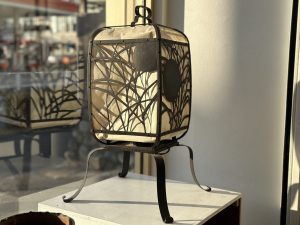針供養の日(愛知県名古屋市千種区姫池通 骨董買取 古美術風光舎)
2023.02.08
皆さま、こんにちは。スタッフMです。
本日の名古屋はとっても暖かく一足早い春のようなお天気。コートなしでも日中は過ごせそうですが、夜になるとまだまだ冷えるようなので油断は禁物ですね。
2月8日、今日は「針供養の日」ということで、この日は裁縫を休んで、古い錆びた針や折れた針など使えなくなった縫い針を集めて社寺に納めたり、豆腐やこんにゃくなどの柔らかいものに刺したりして供養を行う日なのだそうです。
針供養は2月8日と、12月8日とあり西日本では12月8日に行うところが多く、東日本は2月8日に多く行われます。
ちなみに名古屋は2月8日に行われるところが多いのだとか。
ただ、地域に関わらず両日行うところもあるようでして、この日付の違いには「事始め、事納め」の捉え方が影響していると言われています。
この「事始め、事納め」というのは、コトノカミという神様を祀るおまつりで、「事」という字は神様への祈りの文である祝詞を入れた器をつけた木を高く捧げて祖霊を祀るという意味の「史」と、吹き流しを組み合わせた形で、「まつり」を意味しているのだそうです。
コトノカミのまつりは、12月8日と2月8日の2回あり、12月8日が「事始め」で2月8日が「事納め」になる場合とその逆になる場合があります。
この違いはコトノカミが「年神様」か「田の神様」かという違いでして、この時に行う「事」が新年に迎える神様の事なのか、田畑を耕し農耕に勤しむ人の事なのか、という違いで日付が逆転するそうです。
そして、この2月8日と、12月8日のことを「事八日(ことようか)」や、「事の日」などと呼び、この「事八日」の日にお世話になった道具を片付け、感謝するという風習があります。
この風習は定かではないようですが、一つの言われとして中国の「社日(土地の神様をまつる日)に針線(針仕事)を止む」という習わしに起因するというそうなのです。
そして平安時代には貴族の間で行われるようになり、江戸時代に針の労をねぎらい裁縫上達を願うまつりとして広がっていきました。
当時から針仕事は女性にとって重要な仕事だったため、折れた針や古くなった針に感謝の気持ちを込めて柔らかい豆腐やこんにゃくや餅に刺し、川に流したり、土に埋めたり、神社に納めたりして供養をしたという最初に書いた針供養の起源につながってくるということですね。
そしてなぜ、豆腐などの柔らかいものに刺すのかといいますと、これまで硬い生地などを刺してきた針に対し、最後は柔らかいところで休んでいただきたいという気持ちや供養としての気持ちがあると言われています。
針に対しても労いの気持ちを忘れないというところが、日本人の奥ゆかしさといいますか‥良いですよね。
また、「事八日」には針供養以外にも風習がありまして、妖怪や一つ目小僧などの悪神が家を訪れるとされていたため、魔除けとして目籠をくくりつけた竹竿やニンニクなどを庭先に置いたりして、「お事汁」という汁物を食べて魔除けをしたのだそうです。
そして身をつつしむためにその日は針仕事をしてはいけない、山に入ってはならないなどの言い伝えもあるそうですよ。
様々な背景がありますが昔からの言い伝えは現代にも引き継ぎながら、伝統を受け継いでいきたい思います。
では。

Hello everyone. This is staff M.
Nagoya is very warm today, and the weather is like an early spring. It looks like you can get through the day without a coat, but it’s still chilly at night, so don’t let your guard down.
February 8th is “Needle Memorial Day”, so on this day we take a break from sewing and collect old rusty needles, broken needles and other unusable sewing needles and put them in shrines and temples. It seems that it is a day to hold a memorial service by stabbing a soft object.
Hari Kuyo is held on February 8th and December 8th. In western Japan, it is held on December 8th, and in eastern Japan, it is held on February 8th. By the way, Nagoya has many places where it is held on February 8th. However, regardless of the region, it seems that there are places where it is held on both days, and it is said that the difference in this date is influenced by the perception of “starting things and ending things”.
Koto no Kami is a festival dedicated to the god Koto no Kami. It seems that it means “festival” by combining “history”, which means to enshrine, and streamers. The Kotonokami Festival is held twice, on December 8th and February 8th, and there are cases where December 8th is the “start of things” and February 8th is the “end of things”, or vice versa. This difference is whether Kotonokami is “Toshigami” or “Tanogami”, and whether the “things” to be done at this time are about the gods who welcome the new year, or about the people who plow the fields and work hard at farming. It seems that the date is reversed by the difference.
February 8th and December 8th were called ‘Kotoyoka’ or ‘Kotoyoka’, and I was indebted to them on these ‘Kotoyoka’ days. There is a custom to put away the tools and give thanks. It seems that this custom is not certain, but one theory is that it originates from the Chinese custom of “stopping needlework on Shajitsu (the day when the gods of the land are celebrated)”. In the Heian period, the festival began to be held among the nobility, and in the Edo period, it spread as a festival to pray for the labor of the needle and to pray for the improvement of sewing.
Since needlework was an important work for women from that time, broken or old needles were pierced into soft tofu, konnyaku, or rice cakes, poured into rivers, buried in soil, or dedicated to shrines as a sign of gratitude. It is connected to the origin of the needle memorial service that I wrote at the beginning that the memorial service was held by.
As for the reason why the needles are used to pierce soft materials such as tofu, it is said that there is a desire to have the needles, which have been used to pierce hard materials, rest in a soft place at the end, or as a memorial service. increase. The fact that they don’t forget to treat their needles with kindness is one of the modest aspects of the Japanese people, isn’t it?
In addition to the needle memorial service, there were other customs on Koto 8th, and it was said that evil spirits such as yokai and hitotsume-kozō would visit the house, so as talismans against evil spirits, bamboo poles with eye baskets attached, garlic, etc. It is said that they placed them in the garden and ate a soup called “Okoto-jiru” to ward off evil spirits. Also, there are legends such as not doing needlework or going into the mountains on that day in order to respect oneself. There are various backgrounds, but I would like to inherit the tradition while taking over the tradition from the old days to the present age.
********************
ご実家の整理やお片付けなどをされている方のご相談などが多くございます。
お寒くなってまいりましたので、お片付けなどくれぐれもご無理のないようになさってくださいませ。
風光舎では古美術品や骨董品の他にも絵画や宝石、趣味のお品など様々なジャンルのものを買受しております。
お片付けをされていて、こういうものでもいいのかしらと迷われているものでも、どうぞお気軽にご相談下さいませ。
また風光舎は、出張買取も強化しております。ご近所はもちろん、愛知県内、岐阜県、三重県その他の県へも出張いたします。
まずは、お電話お待ちしております。
愛知県名古屋市千種区姫池通
骨董 買取【古美術 風光舎 名古屋店】
TEL052(734)8444
10:00-17:00 OPEN
#骨董#高価買取#古い物#家じまい#古美術#生前整理#針#針供養

